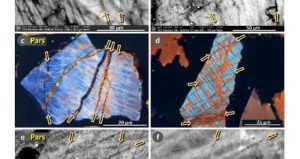
New evidence for a massive, high-altitude explosion caused by a comet impacting the Earth’s atmosphere over North America 12,900 years ago—referred to as the Younger Dryas impact—has been unveiled, following an analysis of fractured quartz crystals discovered at sites along the U.S. east coast of that appear to have been affected by a meteor impact.
Shortly after the ice sheets that covered North America and Eurasia during the Pleistocene epoch began to retreat, the Earth’s climate abruptly re-cooled by 0.6°C (1.1°F) for approximately 1,200 years, a period referred to as the Younger Dryas. While the cause of this cooling is generally accepted to have been the interruption of the North Atlantic Current by an influx of fresh water from the melting ice sheets into the Atlantic—an all-too real threat to our modern-day climate—there is little evidence pointing toward the exact source of this fresh water.
Although the concept is still controversial, the Younger Dryas impact hypothesis (YDIH) posits that an explosion caused by the impact of a sizeable comet with the Earth’s atmosphere triggered a runaway melting event in the remaining North American ice sheet and sparked massive fires across the continent, causing an abrupt change in the global climate that hastened the extinction of numerous species of megafauna and the disappearance of the peoples that comprised the Clovis culture.
Adding to the growing body of evidence supporting the YDIH, a new study conducted by researchers with the University of California, Santa Barbara, examined the presence of geological effects that are caused by the intense heat and pressure of a meteor impact, including meltglass, metallic microspherules, shock-fractured quartz, along with the high levels of iridium and platinum that are signatures of such impacts. The samples, taken from three separate sites in Maryland, New Jersey and South Carolina, were dated to approximately 12,800 years ago and show signs of having been formed by a massive airburst.
“What we’ve found is that the pressures and temperatures were not characteristic of major crater-forming impacts but were consistent with so-called ‘touchdown’ airbursts that don’t form much in the way of craters,” according to UC Santa Barbara emeritus professor James Kennett.
Part of the difficulty of studying the possibility that a meteor of substantial size impacted the Earth at the start of the Holocene is the lack of a large impact crater dating to that era, suggesting that the event was instead an explosive airburst, much like the 1908 Tunguska event that leveled 2,150 square kilometers (830 square miles) of Siberian forest, yet left no impact crater.
The researchers were particularly interested in the shocked quartz recovered from the sites: when a meteor impacts the Earth, the force of the impact causes stress fractures, called lamellae, on quartz crystals in the surrounding rock; examining the patterns formed by the lamellae can indicate whether the impact occurred directly with the ground, or as an airburst.
“In the extreme form, such as when an asteroid hammers into the Earth’s surface, all the fractures are very parallel,” Kennett explained. In the case of an airburst, the patterns are expected to be markedly different, meaning “the pressures and temperatures that produce these fractures will vary depending on the density, entry angle, altitude of the impact and the impactor’s size.”
While traces of the traditional patterns associated with a direct impact were found at the sites, “we mostly see grains that are not parallel,” Kennett continued, referring to the “irregular, web-like pattern of intersecting, meandering lines and surface and subsurface fissures” that were discovered, in contrast to the more regular, parallel patterns formed in ground impact scenarios.
“There’s a whole range of different shocked quartz, so we have to make a well-documented case that they are indeed significant for interpreting cosmic impact, even though they’re not reflecting a traditional major crater-forming event,” Kennett pointed out. “These are from very-low-altitude ‘touchdown’ airbursts almost certainly associated with cometary impact.”
Subscribers, to watch the subscriber version of the video, first log in then click on Dreamland Subscriber-Only Video Podcast link.
This should back up much of what Graham Hancock discussed in ‘America Before’. What interesting news!